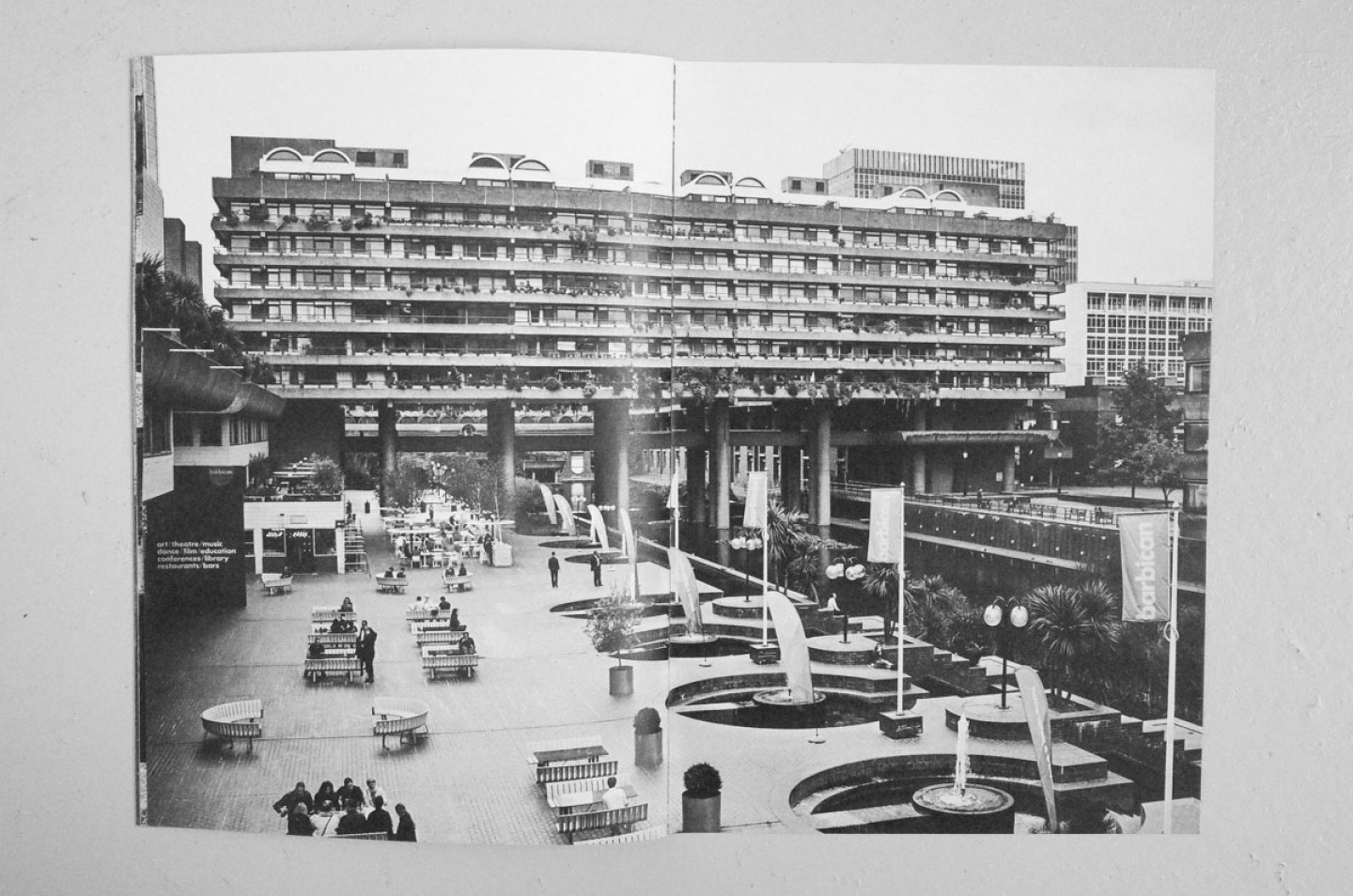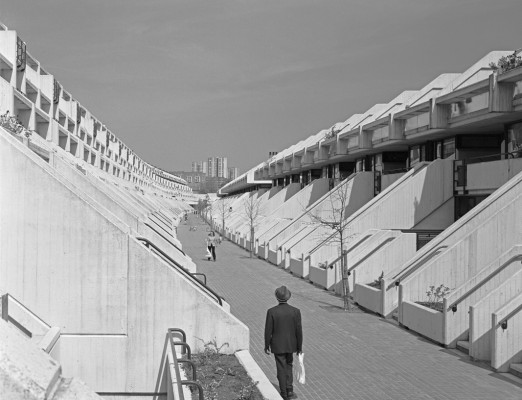It’s 10 years since Café Royal books was launched, we catch up with publisher and photographer Craig Atkinson
Publishing one photo-book a week Craig Atkinson’s Café Royal Books is fast emerging from beloved cult status into a highly respected documentary archive. From social landscapes to life on housing estates to Brutalist architecture, Café Royal Books features both contemporary and lesser known photography of changing Britain and is now housed in public collections by the Tate museum, the V&A and MOMA New York.

(Craig Atkinson, Trellick Tower, Café Royal Books)
Atkinson’s own work documenting the Barbican, Trellick Tower and the Alexandra Road Estate features alongside such work as Daniel Meadows’ factory photos in Bancroft Shed Weaving, George Plemper’s 1976 Thamesmead Riverside School to Tony Hall’s images of London’s East End.

(Daniel Meadows, Bancroft Shed Weaving 1976, Café Royal Books)
These small-run editions of between 24 and 36 pages are remarkable ethnographic documents of people’s relationship with buildings, social spaces and workplaces in Britain over the last 40 years. 
(Patrick Ward, Manplan One, Café Royal Books)
When did Café Royal Books start, what was the brief and the area to explore you set yourself?
Craig Atkinson: It’s 10 years old this year, it started in 2005. My background is Fine Art, I’d always painted large abstract, fairly slow paintings, expensive to make. I made the decision to stop painting and go back to drawing. I did that for a while, and then as the amount of drawings grew I wanted to exhibit them, but I didn’t want to exhibit in a gallery. Café Royal Books was initially set up as a way of exhibiting drawings that wasn’t in a gallery, in a way it answered all that problems that paintings was causing me – the speed, the ability to exhibit internationally, affordably and so on.

(Craig Atkinson, Balfron Tower, Café Royal Books)
You made a decision to show this extraordinary documentation of buildings, architecture, landscapes in a democratic, inexpensive way?
Craig Atkinson: I’m glad it’s apparent, it has become a lot more focused, though I still publish my own stuff it’s become a lot less about me and more about photographers’ archives. I collect a lot of photo-books, they are more traditional photo-books, cloth bound, with foil blocked letters. They are expensive sought after books, but I’ve no interest in making things like that, I prefer affordable books, I like the idea of them being collectable but I don’t want them to become a collectable item, I want them to be publicly accessible.

(Craig Atkinson, Trellick Tower, Café Royal Books)
There is a wide range of subject matter, but you feature a lot of architecture, landscapes, social landscapes, urban spaces, material forms such as concrete features? Where does your interest in that come from?
Craig Atkinson: I can pinpoint no one influence, from a very age it comes from visiting National Trust properties and collecting leaflets, and that informed the leaflet aspect but it also informed the architectural aspect. I always wanted to be an architect, but I ended up dropping Maths and it became more difficult, so I did Fine Art. I’m a lecturer in Preston (the University of Central Lancashire) so coming through Preston when I used to get the bus everyday and go through the bus station which is an iconic Brutalist space, I was initially more interested in watching the people.

(Craig Atkinson, Preston Bus Station: Pie and Blow Dry, Café Royal Books)
I was recording the people for a while, then I started to look at the building a bit more, which got me interested in modernism, brutalism and concrete. The work others submit is more social documentary and street photography, it’s my own research that’s architectural.

(Craig Atkinson, Preston Bus Station: Pie and Blow Dry, Café Royal Books)
The fact that’s its all shot in black and white makes it very expressive of shape, you get to see relationships between people and spaces – there’s George Plemper’s school in Thamesmead where there’s a real sense of relationships not just between the schoolkids but between the built environment, bodies and material forms.
Craig Atkinson: I’ve done a few colour books, not many, it just happens that working with artists and their archives a lot of the work tends in any case to be in black and white, it’s from that time period.

(George Plemper, Thamesmead Riverside School 1976-1978 #2, Café Royal Books)
With the forms in the photos, considering places and people, in an abstract sense it’s stripping them of what they are and thinking of them in terms of line, shape, weight, space and tone, goes back to when I was painting, making formal very abstract paintings. It’s interesting you should pick that up, it’s not something I ever tell people, it’s not something people pick up either. 
(Craig Atkinson, Robin Hood Gardens, Café Royal Books)
In terms of research where do you look for the work, I’m thinking of Manplan One for example, Café Royal Books is not just presenting an interesting set of images but presenting readers an archive of the built environment, the visual imagination of professional architects at a point in time. Where did that come from?
Craig Atkinson: If there’s a particular body of work I’d like to publish, I chase people up. Often the work I’m chasing up, or the work that’s being submitted is not necessarily the one that’s published because we talk around it, look at other work shot at the time. I was working with Patrick Ward on a couple of other books and he mentioned Manplan to me.

(Patrick Ward, Manplan One, Café Royal Books)
It was something I was aware of and I tried to get, but you just can’t get the original Manplan from Architectural Review. That was a real privilege to be able to publish that, and away from its original context. I think it was quite frowned upon when it was originally published, it was different from the strictness of Architectural Review and the country as a whole at that time. Patrick submitted that and we’ve just published Manplan Two.

(Patrick Ward, Manplan Two, Café Royal Books)
There’s more Patrick Ward coming, Manplan Two was never published. I don’t know whether you saw the Nick Hedges show at the Mediaspace, the work for Shelter, in places such as The Gorbals in Glasgow. Rather than being about Britain it’s [Manplan Two] much more focused and stuff that wasn’t used for Architectural Review.
Foyle’s bookshop shows the series really well, gives it good shelfspace.
Craig Atkinson: There yes there’s a bookbuyer Mohara Gill who has been really supportive and influential in getting the small press into Foyles.
In the archive what’s been your most interesting find?
Craig Atkinson: It’s difficult, if I wasn’t interested I wouldn’t publish them. I really like Stephen McCoy’s Housing Estates book and his Skelmersdale book.

(Stephen McCoy, Housing Estates, Café Royal Books)
They really stand out as pieces of work that aren’t as known as they should be, it’s really important work.

(Stephen McCoy, Skelmersdale 1984, Café Royal Books)
Then there’s John Darwell’s study of Sheffield (Sheffield The Remains of Some Buildings Around the Don Valley; Sheffield Tinsley Viaduct; Sheffield in Transition; Sheffield Meadowhall, Hyde Park, Ponds Forge). The extreme that he studies Sheffield, I don’t think anyone has done work like that, and I’ve only published a very small part. Stuff like Manplan, Homer Sykes’ Biddy Boys series, there’s tons I really like.

(John Darwell, Sheffield The Remains of Some Buildings Around the Don Valley;, Café Royal Books)
How do you do the edit?
Craig Atkinson: Sometimes the photographer will do a tight edit, but we’ll still discuss it, it’s never just me, never just them. Some photographers might submit 80 photos for a 20-photo book, so they’ll leave it to me to edit and sequence. I’ve just recently edited a book with Martin Parr that’s coming out in a few weeks, he gave me a set of images and said ‘pick which ones you think will work’, then we talked from there. It’s a surprise really people are so kind with their work and open to suggestion.
Are there any architectural or sociological insights you have learned putting together the books?
Craig Atkinson: Regarding the Brutalist architecture I’m interested in the mass of the buildings, and that goes back to the abstract idea of form, size and contrast I was talking about. Then there’s all that stuff about Brutalism, space, social housing, rehousing. I want the books to be quite neutral, to show something at a point in time. I see them as small bits of information that collectively can say a bit more.

(Craig Atkinson, Alexandra Road Estate, Café Royal Books)
Which have been the most popular books?
Craig Atkinson: The first John Claridge book published sold in half an hour, the same with Jim Mortram his books sell very quickly. It’s amazing but in some ways I’d like them to stay around for a while then I can revisit them. The architectural ones, my own stuff, doesn’t go as quickly. I don’t edition mine, I do a short first edition then it’s open after that. The Barbican especially, I’ve sold a thousand or so of them. With the architectural one if they are not collecting them one-by-one they then come back and buy a set. The whole set is equivalent to the price of a more traditional photobook.
To see more of Café Royal Books and to purchase click here. There is also an extensive collection at Foyles, Charing Cross Road London.

